by Richard Doucette
When I first began climbing I had no idea there was such a thing as climbing literature. A few years into it, I was hanging out with all these AMC types. It seemed they were all a hundred years old and knew a lot more than me. I made a fool of my self in a conversation when I admitted to not knowing who Fred Becky was. This is like a basketball fan not knowing who Red Auerbach is…or a young republican unfamiliar with Ronald Regan. I figured I oughta read up on things before I make a complete ass of myself. But where to start? I looked over the bookshelves at the local climbing shop. I picked up a copy of Chris Jones’ “Climbing in North America”. This was a good choice. It wasn’t literature or anything, but gave me a good overview of the sport and a lot of names to look up. At least now I knew who this guy “Whitney Gilman” was.
So I started reading and about 10 years later I have a few opinions on what’s worth reading among climbing literature (and books too). I have asked others to recommend their favorites and this has expanded my list. I will refrain from saying these are the best books; they are just the ones I like and can recommend.
First off, I will not make any recommendations regarding books on technique or other reference material (although “Climbing in North America” and “Mountaineering, Freedom of the Hills” should be read by all. (There I go recommending things in a category I said I would not get into.)
Here is my list of favorites:
“No Picnic on Mount Kenya” by Felice Benuzzi
Amazing story. Check this out, an Italian diplomat is imprisoned in a POW camp in Africa in WW2. Gets bored, sees this really nice mountain off in the distance. Decides to escape and climb the mountain. Gathers up a few prisoners to go with him. Scrounges and manufactures gear and provisions. The approach is through uncharted parts of deep/dark Africa. You won’t believe what they do after the climb…
“The White Spider” by Heinrich Harrer
A look at all of the ascents of the Eiger’s north face. See what one can do even if you forget your crampons…and have Anderl Heckmair to lead the hard stuff.
“Starlight and Storm” by Gaston Rebuffat
Accounts of climbing the 6 great north faces in the Alps, by the first person to climb all of them. Rebuffat’s great joy of climbing shines through. (If I had categories for guidebooks or coffee table books, Rebuffat’s “Mont Blanc Massif, The 100 Finest Routes” would make the list in both.)
“Annapurna” by Mauric Herzog
I believe this was (at least until recently) the highest selling mountaineering book in History. The story of the first ascent of an 8000 meter peak. Those French are a tough lot. The book was a bit too…something…I never could quite put my finger on it. Herzog just made everything sound too positive. People were losing fingers and toes left and right, it can’t be all THAT positive. Turns out maybe it wasn’t. Consider reading “True Summit” by Dave Roberts. Some might not appreciate revisionist history. Herzog may have been brought down a notch by Roberts, but then again so was Rebufatt. Terray comes out on top though.
“The Breach: Kilimanjaro and the Conquest of Self” by Rob Taylor
If you read this one, just remember that it is only one person’s account of a tragic climb. The writer comes across as too angelic, and his climbing “partner” was likely not the evil one he was portrayed to be. But a great book nonetheless.
“Seven Years in Tibet” also by Heinrich Harrer.
Just barely made the list of “climbing” books because it starts out as a climbing expedition but goes far beyond that. One of the great stories of all time.
“Touching the Void” by Joe (I’ve fallen and can’t get up) Simpson
This appears on everyone’s list of favorites. An absolutely amazing story. I will never bitch again if I sprain my ankle and have to limp an hour back to the car. When you have a bad day, or a bad climb, or a bad trip, remember this story. Your day coulda been worse than it was.
Also in the “I am lost and screwed, now what do I do” category, are a few of my other favorites. In “Into the Wild” by John Krakauer, the protagonist doesn’t climb, but Krakauer gives some personal accounts of his own climbing. Great book for the nonclimber. Also, any book about Shackleton is a great read (Alfred Lansing’s account is my favorite). This amazing story ends with a brief but still significant climb. “The Long Walk” by Slavomir Rawicz is another hard to believe but true story. Similar to Harrer’s “7 Years” but with no rest after the escape. Not much actual climbing, but after reading this you will never ever complain about a “long” approach. Trust me.
But, getting back to real climbing books, Honorable Mention goes to the following:
“In the Throne Room of the Mountain Gods” by Galen Rowell
I knew the guy could take great pictures, but he can write too. It’s interesting to read a book about an expedition which failed miserably. This is one of the few books where the writer had access to the journals of several of the other expedition members. These accounts are woven into a great book.
“Yankee Rock and Ice” by Guy Waterman (Rest in Peace)
A must read if you are from these parts. Worth reading just to try and find the picture of Bill Atkinson among the other Appies, and the very 70s looking shot of Al (I once had a lot of hair) Rubin.
“A Most Hostile Mountain” by Jon Waterman
Waterman (local boy) re-enacts the Duke of Abruzzi’s sail to Alaska and ascent of Mt. St. Elias; thought at the time to be the tallest peak on the continent.
“Burgess Book of Lies” by Adrian and Alan Burgess
These two crazy characters kept turning up in other books. I finally found out they had a book of their own. I would love to party with these cowboys…but I would likely end up dead.
“K2 Triumph and Tragedy” by Jim Curran
One of the first climbing books I read. Tragic story, well written. Other writers (including the aforementioned Burgess Twins) have written about this same season on K2 when 13 die on the mountain.
One of the best “other accounts” of the 1986 K2 story is covered in “The Endless Knot”, which I discovered in the “Kurt Deimberger Omnibus”. (Omnibus = collection of the works of one author.) I read in that hefty volume that Deimberger was one of only two men to complete first ascents of two 8000 meter peaks. Hermann Buhl is the other; and of course he has an omnibus also (but doesn’t call it one). “Nanga Parbat Pilgramage” is a fine account of the life of this important individual. He was doing “light and fast” long before Messner, who was before Bouchard or Twight or these other Johnny-come-latelies. Other good Omnibuses include: “Boardman Tasker Omnibus” by Joe Tasker and Peter Boardman; and (my favorite) “Six Mountain Travel Books” by Eric Shipton. If you call yourself a mountaineer and don’t know who Shipton and Tillman were, then shame on you. That might even be worse than not knowing who Fred Becky is…
But the typical Omnibus can be bit cumbersome. Collections of Short Stories are easier for most people to handle, particularly for us TV-degenerated Americans. Among this category one must include:
“Eiger Dreams” by John Krakauer. Stories of climbing in Chamonix and The Eiger are a good read.
“Tales from the Steep” by John Long includes rousing stories by one of the great storytellers in the sport. Long’s description of a notable fall (referred to as a “Homeric whipper”) in the “Green Arch” is particularly memorable.
“Thin Air, Encounters in the Himalaya” by Greg Child (Child’s “Postcards from the Ledge” is good too. A catchy title always helps.)
You will note that I haven’t yet mentioned the most popular mountaineering book ever, probably sold more copies than “Annapurna”…well I will add it here. John Krakauer’s “Into Thin Air” is a riveting account of a very well known tragedy. But I am sick and tired of reading about Everest. Poor Mallory and Irvine roll over in their respective graves every time a new book is written on this topic. But, I will make a deal with you…I will give it at least an honorable mention if you will promise to read Anatoli Boukreev’s “The Climb” also. Its only fair, as Boukreev came out looking a bit shabby in Krakauer’s book. Too bad Henry Barber (oops that’s Harley) never wrote a book to respond to Taylor’s “Breach”. Then again maybe he did and I have not read it.
That’s it so far; but there are still many books to read. Some are old and hard to find…others are yet to be written. I haven’t yet read anything by the two men who were perhaps the best mountaineers of our time: Reinhold Messner and Jerzy Kukuczka. Messner has many to chose from, the late Kukuczka has one that I know of. (Note: the Poles make even the French look like pansies.) I still haven’t read “Seven Summits” by Bass, Wells & Ridgeway or Paul Pritchard’s “Deep Play”, but I will. Hey, I am a slow reader.
Two things I just realized after writing this. First, three of the books mentioned here include escapes from prison camps…perhaps escapism, striving for freedom and disdain for authority are important themes in climbing literature (and climbing itself). Second, none of the recommended books is written by a women. Either I need to branch out a bit more (Julie Tullis…Alison Hargreaves…) or maybe there just aren’t enough women in prison camps.
–
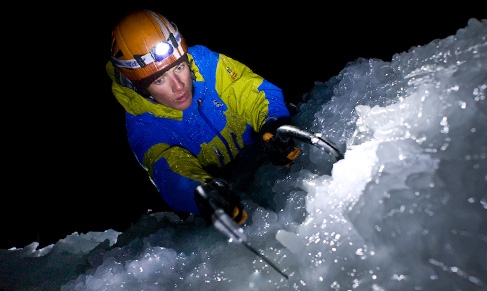 Petzl, the originator of the modern headlamp, today announced the launch of a global “Power of Light” Photo/Video contest, in line with the launch of the new series of Tikka2 and Zipka2 headlamps.
Petzl, the originator of the modern headlamp, today announced the launch of a global “Power of Light” Photo/Video contest, in line with the launch of the new series of Tikka2 and Zipka2 headlamps.
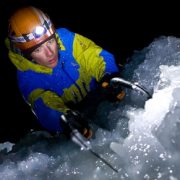
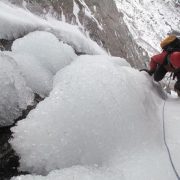



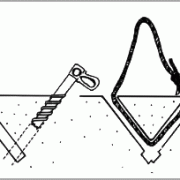
 More and more recently I’ve come across all sorts of gear left on ice climbs, left when people rap off or when people can’t finish a route and rap or lower off. In the interest of keeping the chat room posturing to a minimum and to help preserve everybody’s rack, here is how I place a V-thread and retreat from an ice climb. (I feel like I’m uniquely qualified to write this, as I have retreated off of ice climbs in fourteen states, including almost every route at lake Willoughby and in smugglers notch.) A V-thread is stronger than a screw because the surface area of the ice you are supporting your weight on is much greater than that of the threads on an ice screw. Many people don’t trust them however, so what follows is my method of backing up and testing rappel anchors in general, as well as directions for making a V-thread.
More and more recently I’ve come across all sorts of gear left on ice climbs, left when people rap off or when people can’t finish a route and rap or lower off. In the interest of keeping the chat room posturing to a minimum and to help preserve everybody’s rack, here is how I place a V-thread and retreat from an ice climb. (I feel like I’m uniquely qualified to write this, as I have retreated off of ice climbs in fourteen states, including almost every route at lake Willoughby and in smugglers notch.) A V-thread is stronger than a screw because the surface area of the ice you are supporting your weight on is much greater than that of the threads on an ice screw. Many people don’t trust them however, so what follows is my method of backing up and testing rappel anchors in general, as well as directions for making a V-thread.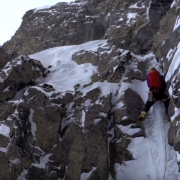

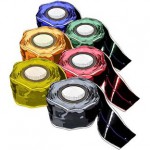
 Originally developed for the military, this new silicone tape is ideal for wrapping your ice tool. And with the 6 different colors it is easy to individualize your tools.
Originally developed for the military, this new silicone tape is ideal for wrapping your ice tool. And with the 6 different colors it is easy to individualize your tools.